Macronutrients and Fat Loss: Optimizing Your Diet
Did you know more than 650 million adults worldwide are seen as obese? This big number shows a serious health issue. It points out the need for better nutrition to lose weight.
Some people try very low calorie diets or trendy eating plans, often without great results. Studies suggest focusing on macronutrients and fat loss might work better. By knowing how carbs, proteins, and fats work together, you can make a diet plan for losing fat. This plan doesn’t require cutting calories too much.
Truth is, no single plan fits everyone. What helps your friend might not help you, and that’s okay! Finding the best way to manage weight involves tailoring your diet. It also means having a balanced view of macronutrients. This approach is both doable and fun.
The Importance of Macronutrients for Health and Weight Loss
Knowing about macronutrients helps us stay healthy and lose weight. These nutrients include proteins, carbohydrates, and fats. They are key to our energy, muscle function, and wellness.
Proteins are essential for our tissues and immune system. Men need about 56 grams and women need 46 grams daily. Not enough protein can cause muscle loss and other health problems.
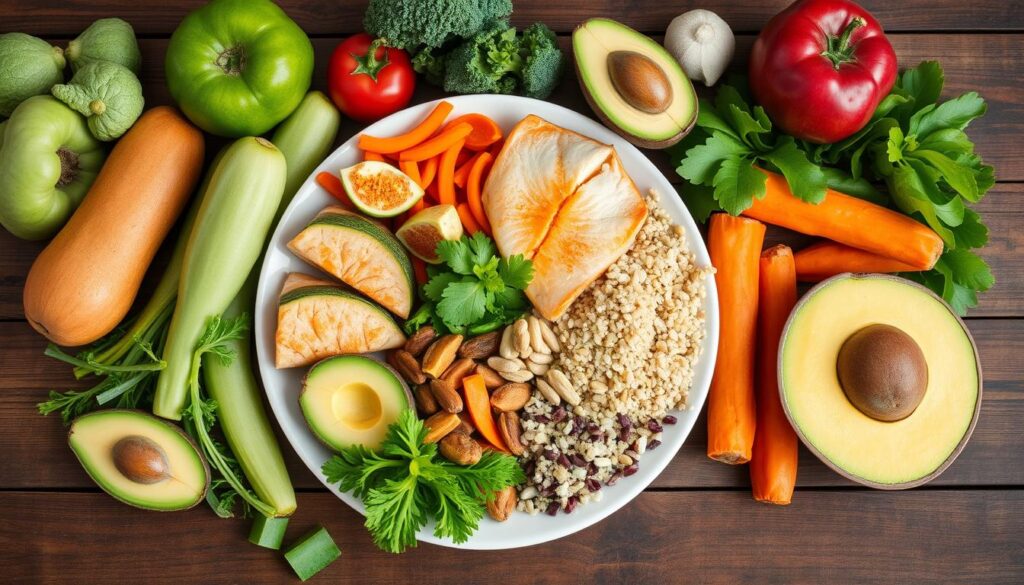
Carbohydrates are our main energy source. They should make up 45% to 65% of our daily calories. Picking healthy carbs is crucial to avoid weight gain and diseases.
Fats are needed for hormone production and absorbing nutrients. Healthy fats should be 20% to 35% of our daily calories. Choosing the right fats helps with weight loss.
Having the right mix of these nutrients is important for our weight. It helps whether we want to lose, gain, or maintain our weight. To learn more about macros, click here.
Understanding Macronutrients: Carbohydrates, Proteins, and Fats
Macros are key to a good diet plan. Carbohydrates, proteins, and fats each have special jobs in keeping us healthy and helping us lose weight.
Carbs are our main energy source. They give us glucose, which powers our cells all day. Healthy carbs come from whole grains, fruits, veggies, legumes, nuts, and seeds. Fiber is a type of carb that keeps our digestive system happy and our health top-notch.
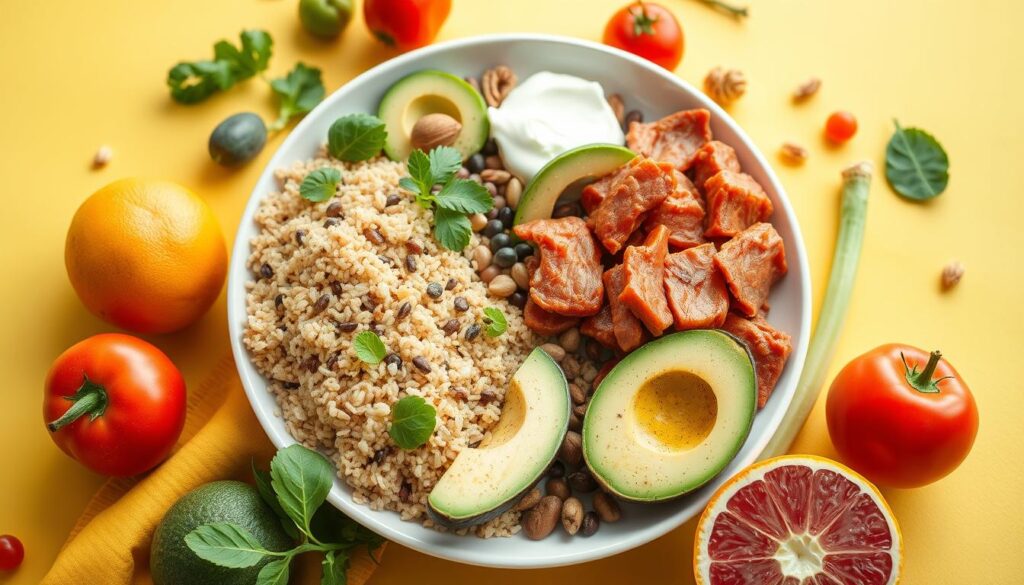
Proteins are crucial for muscle upkeep and repair. They build tissues and handle different body functions. Foods like tofu, beans, eggs, and fish are great protein sources. Some foods, like animal products and quinoa, have all nine essential amino acids. These are called complete proteins. Others might miss one or more, so eating a variety is key.
Fats are important too, even if people often get them wrong. They give energy, help with hormone balance, and make sure our body absorbs nutrients well. We should eat healthy fats, especially unsaturated ones from avocados and olive oil. Omega-3 fatty acids are vital for our brain and must come from our diet.
Knowing how carbohydrates, proteins, and fats work makes macros easier to understand. This knowledge lets people create diets that are great for their health and weight goals.
Macronutrients and Fat Loss: Finding Your Ideal Ratios
Finding the right balance of macronutrients is key to a great diet for losing fat. This approach isn’t the same for everyone. What works depends on your activity level and goals. Experts often say that carbs should be 40%-50% of what you eat each day. Protein should be 25%-35%, and fats around 20%-30%.
Yet, some prefer to eat less carbs, about 5%-15%, and more fat, about 45%-65%. A common mix is 40%-50% carbs, 30% protein, and 20%-30% fat. Finding what works best for you involves some testing.
To lose weight, try cutting 500 calories a day. This might help you lose about a pound each week. Begin by figuring out your Total Daily Energy Expenditure (TDEE). Let’s say it’s 2000 calories. Eating 1500 calories daily will help set your macronutrient targets.
- For 40% carbohydrates: 1500 * 0.40 / 4 = 150 grams
- For 30% protein: 1500 * 0.30 / 4 ≈ 112.5 grams
- For 30% fat: 1500 * 0.30 / 9 ≈ 50 grams
As you move forward, adjusting your nutrient mix might be needed. Check on this every 2-4 weeks. See what gives you energy and controls your hunger. Enjoy finding the best diet for you. Remember, what’s good for some may not work for you. Stay curious and open to changes!
The Role of Carbohydrates in Your Diet
Carbohydrates sometimes are seen in a negative light when it comes to losing weight. But, they are essential for giving our bodies energy. Knowing the difference between complex carbs and simple carbs is important. This knowledge helps you lose fat and maintain a healthy diet.
Complex vs. Simple Carbohydrates
The difference between complex carbs and simple carbs is important for weight loss:
- Complex carbs are in whole grains, legumes, and veggies. They break down slowly, giving you constant energy and keeping your blood sugar stable.
- Simple carbs are found in sugary treats and drinks. They cause quick rises in blood sugar, which can make you feel tired afterward.
Choosing complex carbs helps you manage your weight loss carbs, ensuring your energy doesn’t dip during the day.
Recommended Intake for Weight Loss
The diet guidelines suggest making carbs 45-65% of your daily calories. For a 2,000-calorie diet, you should have about 275 grams of carbs each day. To help with fat loss, you should:
- Try to get 25 to 30 grams of fiber each day, even though most people don’t eat enough.
- Keep your added sugars below what the American Heart Association recommends: 25 grams for women and 36 grams for men.
Focus on high-fiber, nutrient-rich carb sources to improve health and reach your weight loss targets. By understanding the difference between complex and simple carbs, you can make choices that help with weight management and overall health.
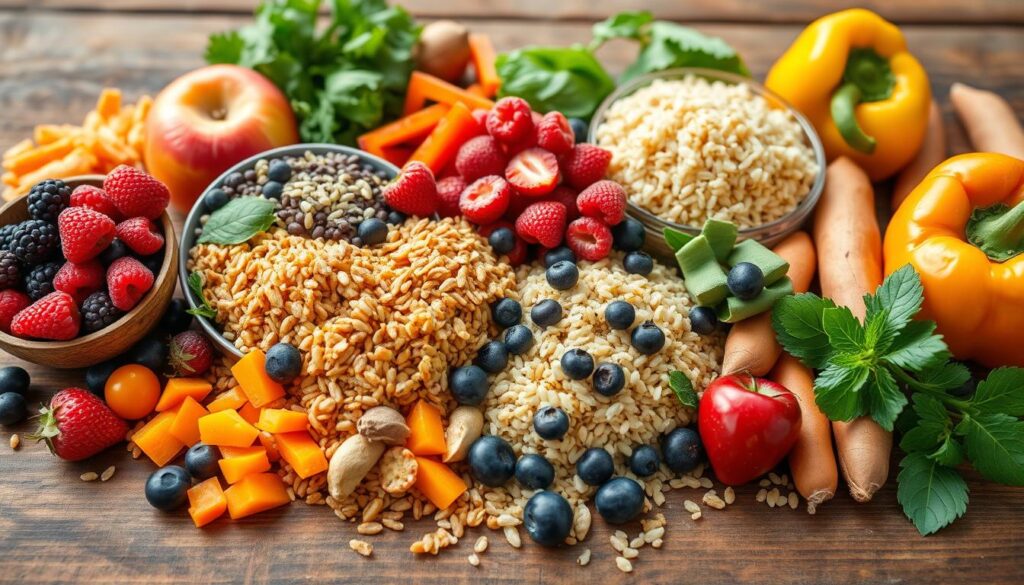
The Significance of Protein for Fat Loss
Protein is vital when you’re trying to lose weight. It helps build and repair muscle and makes you feel full. This fullness makes it easier to eat less. Adding enough protein to your diet helps keep muscle and lose fat.
Lean Protein Sources You Should Include
Choosing lean protein is key for losing fat. Here are some great choices:
- Chicken breast
- Fish (like salmon or tuna)
- Tofu and tempeh
- Legumes such as lentils and chickpeas
- Egg whites
- Greek yogurt
These options give you the amino acids you need. They also make meals enjoyable and healthy. Adding lean protein to what you eat can boost your health and help lose fat effectively and healthily.
Protein’s Role in Muscle Retention during Weight Loss
Keeping muscle while losing weight is important. High protein diets are great for keeping muscle when you eat fewer calories. Experts suggest consuming 1.6 to 2.7 g/kg of body weight in protein to preserve muscle.
Meeting protein targets can raise your metabolism. This helps keep weight loss going. Research shows high protein diets lead to more fat loss and maintain muscle. This makes protein essential for losing fat.
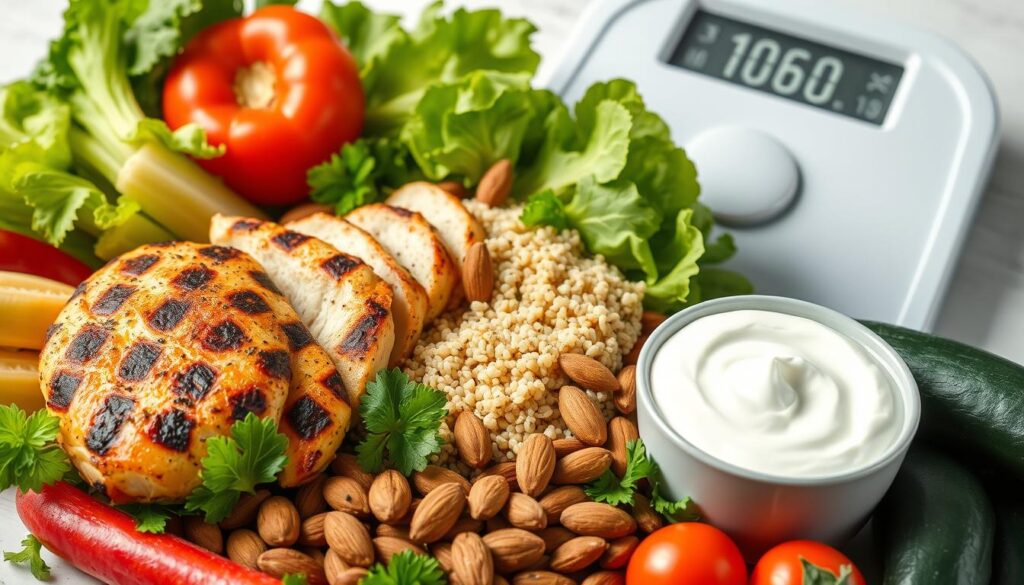
Healthy Fats and Their Impact on Weight Management
Healthy fats are often seen in a bad light when losing weight. It’s time to change this view. Including healthy fats for fat loss like avocados, nuts, and olive oil, can help with weight control. These foods are full of nutrients. They also give you the fats your body needs to work its best.
Healthy fats do more than just taste good. They make you feel full longer. This means you’re less likely to crave snacks that can mess up your diet. Adding fats to your eating plan is crucial. The World Health Organization says adults should get 20-35% of their calories from fats. This highlights their role in a balanced diet.
Be mindful of the kinds of fats you eat. Stay away from saturated and trans fats, which are bad for your cholesterol. Opt for monounsaturated and polyunsaturated fats instead. These are good for your heart. By doing this, you can lower bad cholesterol and boost your overall health, helping your weight loss.
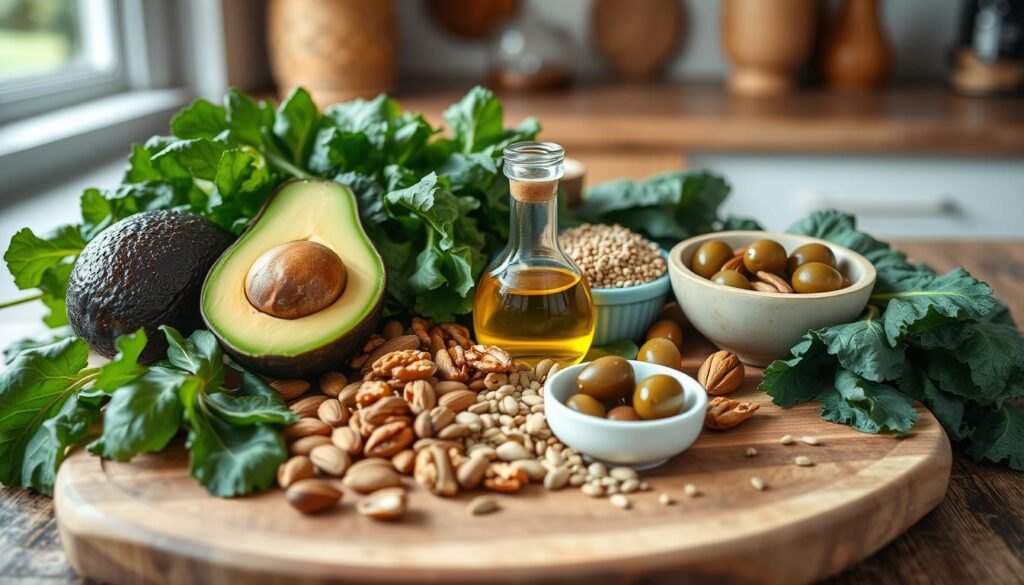
It’s not hard to switch to healthier fats. Try replacing butter with oils like canola or sunflower. Choose lean meats and low-fat dairy to make your meals fulfilling and on track with your goals. The aim is not to cut fats out completely but to choose better ones for a healthier life.
In short, don’t overlook the importance of healthy fats in your diet. They’re key not just for losing weight but also for giving your body vital nutrients. Let’s stop the myth that all fats are harmful. Make smart fat choices and they’ll be part of your success in getting healthier.
Calculating Your Macronutrient Needs
Figuring out how many macronutrients you need is key to managing your weight well. You start with your Total Daily Energy Expenditure (TDEE) to know how many calories to eat. Then, you set macro ratios that match your fitness goals. This helps tailor your diet correctly.
Understanding Total Daily Energy Expenditure (TDEE)
Total Daily Energy Expenditure is the total calories you burn each day. It combines your Basal Metabolic Rate (BMR) and your activity level. To find your TDEE, first estimate your BMR with formulas like the Mifflin-St Jeor Equation or the Katch-McArdle Formula. The second one is better if you know your body fat percentage.
Here’s an easy way to guess your BMR:
- For men: 10 × weight (kg) + 6.25 × height (cm) – 5 × age (years) + 5
- For women: 10 × weight (kg) + 6.25 × height (cm) – 5 × age (years) – 161
After figuring out your BMR, multiply it by how active you are to find your TDEE:
- Sedentary: x 1.2
- Lightly active: x 1.375
- Moderately active: x 1.55
- Very active: x 1.725
- Extra active: x 1.9
Setting Your Macronutrient Ratios
With your TDEE known, you can work out your macros by setting the right ratios. Strive for a balance that meets your health goals. Common advice is:
- Carbohydrates: 45%–65%
- Proteins: 10%–35%
- Fats: 20%–35%
For example, on a 2,000-calorie diet for losing weight:
- Carbohydrates: 200 grams (800 calories)
- Proteins: 150 grams (600 calories)
- Fats: 67 grams (600 calories)
Online calculators can help, but you might need to adjust things yourself. Keep track of your progress and adjust your diet as needed. Adapting your macro ratios as you go can make your diet work better for you.

Benefits of Tracking Macronutrients
Tracking your macronutrients can greatly improve your weight loss efforts. It helps you become more aware of your eating habits. You start to understand which foods are good or bad for your goals.
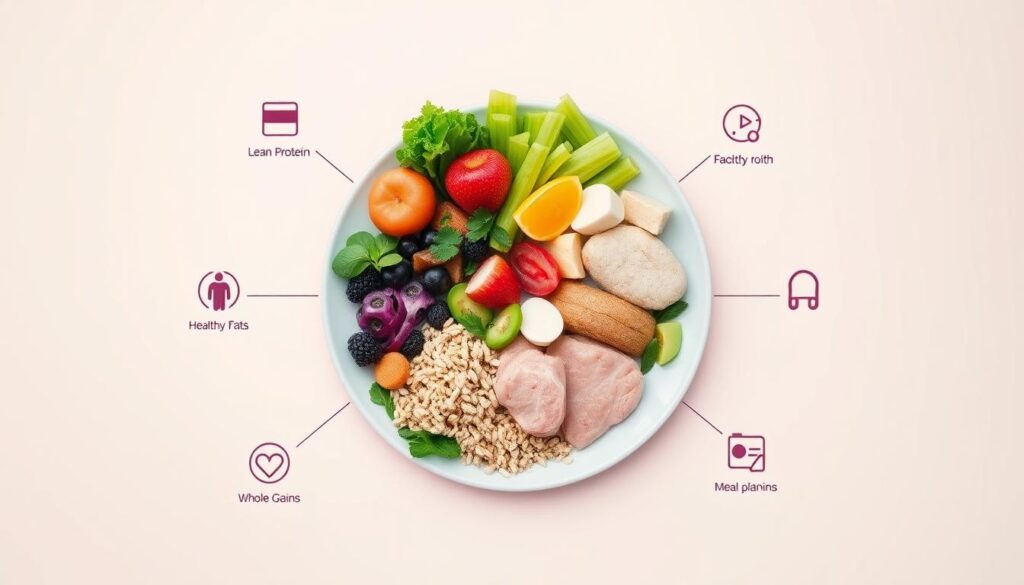
Knowing your macros prevents you from not getting enough nutrients. This balance is key for energy and staying healthy. For example, if you’re not eating enough protein, you might feel tired all the time. That’s not what you want when you’re trying to lose weight.
- Promotes focus and motivation toward dietary goals.
- Facilitates adjustments to intake based on progress and body response.
- Enhances knowledge of caloric density—4 calories per gram for carbohydrates and proteins, and 9 calories per gram for fats.
- Supports the concept of “If It Fits Your Macros” (IIFYM), allowing flexibility in food choices.
Tracking can boost your metabolism, especially with protein, which can raise it by 15 to 30%. By keeping an eye on your macro ratios, you improve your chances of losing weight and keeping it off. For those dealing with health issues like chronic kidney disease, it’s especially helpful.
Keeping track of your macros really changes the game. It turns dieting into a powerful, manageable part of your life. This way, you get to take control of your eating and your health.
Meal Planning for Effective Weight Loss
Meal planning is key to losing weight successfully. It helps you enjoy meals that fit a low calorie diet without feeling like you’re missing out. By choosing your meals wisely, you’ll cut calories and nourish your body well.
Creating a Low Calorie Diet
Start by tailoring a low calorie diet to your needs. Use the Mifflin-St Jeor Equation to figure out how much energy you spend daily. Then, creating a calorie deficit by eating 20% less helps you lose weight. Remember these details:
- Carbohydrates should form 45–65% of your daily calories, with 4 calories per gram.
- Proteins, providing 4 calories per gram, should make up 10–35% of what you eat.
- Fats, with 9 calories each gram, are 20–35% of your total calories.
- Men need 38 grams and women 25 grams of fiber daily for good digestion.
Incorporating Diverse Food Groups
For weight loss, eating a variety of foods is important. Mixing different food groups gives you essential vitamins and minerals. Try to include:
- Colorful fruits and veggies for antioxidants and low calories.
- Whole grains like quinoa and brown rice for long-lasting energy.
- Lean proteins such as chicken, turkey, and legumes for muscle health.
- Healthy fats from nuts, seeds, and olive oil to keep you full.
With flexible dieting, you don’t have to give up all your favorite foods. This method lets you be creative while sticking to your diet. Taking your time to figure out what works best for you is important. Keep planning your meals, and soon, eating a well-rounded, low calorie diet will feel natural.
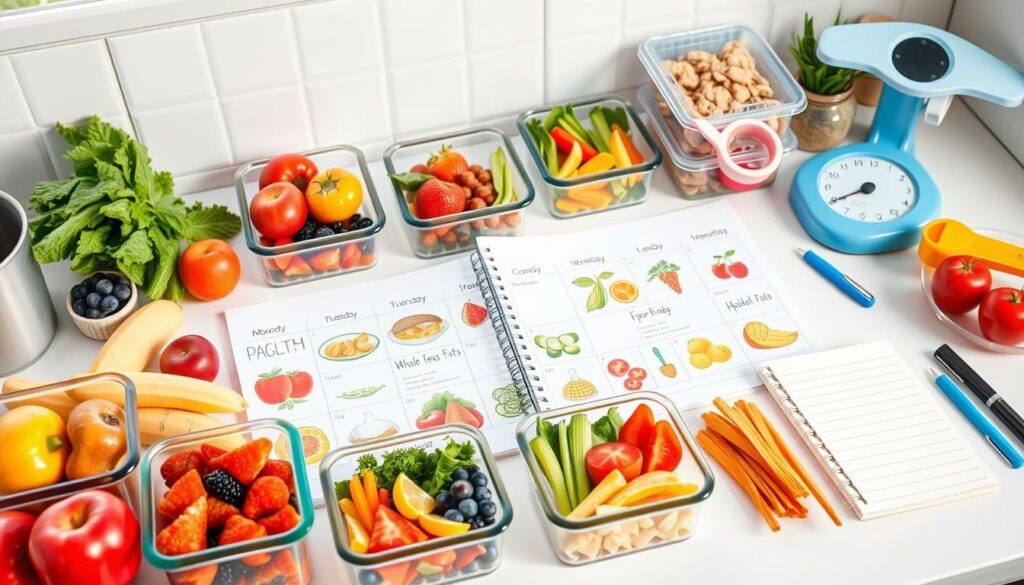
Adjusting Your Macronutrient Ratios Over Time
As you work on losing weight, adjusting macros is key. You might start with a set ratio that seems perfect. But, as your body changes, your macros should change too. This helps you avoid hitting a standstill and keeps you motivated, both very important in any diet.
Every few weeks, take a look at your progress. If your goals are met within 5 grams for 2 to 4 weeks but you see no change, it’s time for a change. For example, if following your macros doesn’t change your body or weight, you need to adjust your diet for better fat loss.
- Think about cutting carbs by 20 grams and upping fats by 5 grams.
- Or, you could reduce fats by 5 grams for each 10 grams of carbs you add.
Make changes in a systematic way. If you’re eating 1740 calories—with 150 grams of protein, 60 grams of fats, and 150 grams of carbs—a small change could lead to 1735 calories. This might mean 55 grams of fat and 160 grams of carbs. Picking the right time and amount is crucial when adjusting macros.
To create an effective calorie deficit, start with reductions from your daily needs. If your Total Daily Energy Expenditure (TDEE) is 2000 calories, starting a 500-calorie deficit nets 1500 calories a day. This aligns with macros that fit your diet and lifestyle.
Think of this as an experiment, not a strict rule. It’s about finding what works for you. Adjusting macros helps keep your diet varied and your goals on track. Enjoy the journey and be open to changes.
For extra help, here’s a great guide on calculating weight loss macros.
Common Myths about Macronutrients and Weight Loss
Myths about losing weight can be confusing. Advice often leads to macronutrient misconceptions, throwing off many dieters. For instance, some think cutting all carbs is key for weight loss. Yet, carbs fuel our brains and red blood cells, proving crucial for health.
- Refined carbohydrates, found in processed foods, require moderation.
- Complex carbohydrates are your allies, keeping you fuller for longer, which is key for weight maintenance.
Another widespread myth is focusing solely on high protein diets. Protein helps keep muscles strong, but don’t ignore a balanced diet’s benefits. Studies even suggest that diets low in fat could raise the risk of health issues. This challenges the claim that cutting fat is always the best move.
Dispelling diet myths can feel freeing. Cutting all fats, for example, might lead to temporary weight loss but often results in quick regain. Healthy fats are vital for our metabolism and help us feel full. Understanding more than just “calories in, calories out” helps us see how our bodies truly work.
Research also tells us meal timing, like eating late, isn’t as crucial as believed. What matters more is the quality of the food we consume. Skipping meals may lower calorie intake, and intermittent fasting could help regulate blood sugar.
Ultimately, understanding macronutrients and making wise food choices is key for lasting health. To see through the nutrition myths, we must look at the facts and learn to tell reality from myth.
Personalizing Your Diet for Sustainable Fat Loss
Finding your ideal diet involves both science and art. Customized eating plans can greatly impact your fat loss journey. By aligning with your body’s signals, likes, and daily life, you create an eating plan that’s easy to follow. It becomes a flexible path, letting you enjoy meals while heading towards your aims.
The U.S. Department of Agriculture suggests a balance: 45%-65% carbs, 10%-35% protein, and 20%-35% fat. Knowing these percentages leads to a diet rich in veggies and whole grains, lean meats, and good fats. Such a diet repairs the body, gives energy, and keeps you full, key for losing fat sustainably.
Aiming to lose 1-2 pounds weekly is healthy and leads to long-term success. Apps like MyMacros+ or MyFitnessPal help monitor your food intake. They allow easy tweaks to your diet plan. With dedication and the right tools, revamping your diet and reaching your weight goals becomes doable, all while still finding joy in eating.
- The Role of Protein in Fat Loss - January 21, 2025
- Macronutrients and Fat Loss: Optimizing Your Diet - January 19, 2025
- Top Fat Loss Tools for Effective Weight Management - January 19, 2025
